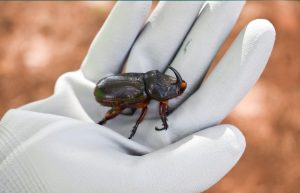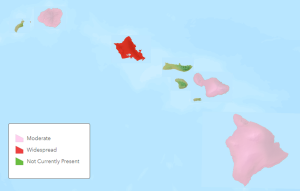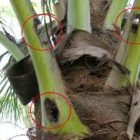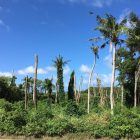Coconut rhinoceros beetle
COCONUT RHINOCEROS BEETLE (ORYCTES RHINOCEROS)
- Regulatory Status: Hawaii Department of Agriculture’s List of Pests Designated for Control or Eradication (Chapter 4-69A) / Hawai’i Injurious Wildlife (Exhibit 5, Chapter 13-124)
- What You Can Do: Compost management and use nets to protect trees {For More See Below}
- Report this species if seen on any island (except O’ahu)
- Intervention Status: Eradication all Islands, except Containment on O’ahu,
{Click Tabs} DESCRIPTIONIMPACTSDETECTING CRB IMPACTS ON TREESERADICATION & CONTROL METHODSWHAT YOU CAN DOo Adult: 2” length, black, with a horn / Larva: Up to 3” white, “C-shaped” body
o Adult CRB are nocturnal and can fly up to two miles if looking for a food source. Female Beetles lay 50-140 eggs in their lifetime (4-9 months)
o The Coconut Rhinoceros Beetle is native to Africa, China, Myanmar/India, and Southeast Asia o First found in Hawaii in 2013 at the Joint Base Pearl Harbor-Hickam
o In 2023 multiple populations were discovered on Kauai o Siting’s also occurred on Maui and Hawaii islands, but established populations have not been confirmed o They do not bite, but CRBResponse advises they should be handled with care as they may carry disease because they live in dirt and mulch o Report siting of CRB to 643-Pest.org and see the ERADICATION & CONTROL METHODS TAB regarding how to handle and dispose of specimens
o CRB jeopardizes the economy, the entire ecosystem, agriculture, and food security (Citation – Maui County) o To feed, CRB bite and bore into emerging palm fronds creating holes in the top of the tree o Examples of Damage to Palms (CRB Response)
o CRB can kill palms and other trees if they burrow and eat below the bark
o CRB prefer to feed on coconut, royal, date, and fan palms (including Pitchardia), but if these trees are unavailable CRB will feed on Hala, Taro, Banana, Pineapple, and Sugarcane
o Adult CRB feed on tree sap but do not typically stay in trees very long. Larva will feed on nearly any moist, rotting or composting organic matter from fallen logs, tree stumps, green waste, grass clippings, manure, and sawdust piles
o On Hawaiʻi Island, these invasive beetles pose a serious threat to five endemic species of loulu palms (Pritchardia beccariana, P. gordonii, P. lanigera, P. schattaueri, and P. maideniana), with three of these species already designated as endangered or critically imperiled
o CRB damage cultural staples like Hala and Taro which impacts Native Hawaiian cultural practices. Protecting these plants is critical for preserving local heritage and maintaining a healthy, balanced ecosystem and local economy (Maui County)
o Recognizing the Beetle and Its Larvae (Maui County )
o Boreholes: CRBs create noticeable boreholes in crowns of palm trees
o ‘V’-Shaped Cuts and Holes in Fronds: As palm fronds emerge ‘V’-shaped cuts or holes along the central spine or center vein are signs of feeding
o Infested trees often show a general decline in health. o Report siting of CRB to 643-Pest.org
o CRB Response advises that “green waste” management is the most effective method to address infestations, but states that all of the following Treatment Methods (listed below in-part) should be taken, when applicable:
o Remove CRB breeding habitat including mulch, compost, rich soil, stumps, dead trees, and plant waste piles o Use of Green Waste bins to dispose of organic materials
o Pesticides can be applied as foliar sprays, systemic injections, or systemic root drench (systemic pesticides; imidacloprid, acephate)
o Non-adult CRB can be effectively prevented from attaining adulthood if their breeding material is treated on a consistent four-month basis o Place netting in crowns of short trees
o Cleaning debris (CRB habitat) from the top of trees o Keep specimens in a sturdy container (glass, bucket, or sealed metal can). Dispose of CRB by freezing or other methods as detailed in the Statewide CRB Communication Plan
o Check mulch piles and green waste for breeding populations
o Allow authorized specialists access to your property to detect beetles and possibly hang a trap (Except O’ahu) o Do not transport mulch.
o Oahu residents are urged to call the CRBResponse team for assistance at 808-679-5244, or Coconut Rhinoceros Beetle Response Team, or [email protected].
o If you see this species, call 643-PEST and/or visit 643pest.org
o If CRB or larva are found in purchased mulch/compost, do not use infested product, return it to the store.
o Cutting down an infested tree is not recommended as this might push them to feed on another tree o See the ERADICATION & CONTROL METHODS TAB or the Statewide CRB Communications Plan regarding handling and disposing of specimens
DESCRIPTIONIMPACTSDETECTING CRB IMPACTS ON TREESERADICATION & CONTROL METHODSWHAT YOU CAN DO
o Adult: 2” length, black, with a horn / Larva: Up to 3” white, “C-shaped” body
o Adult CRB are nocturnal and can fly up to two miles if looking for a food source. Female Beetles lay 50-140 eggs in their lifetime (4-9 months)
o The Coconut Rhinoceros Beetle is native to Africa, China, Myanmar/India, and Southeast Asia o First found in Hawaii in 2013 at the Joint Base Pearl Harbor-Hickam
o In 2023 multiple populations were discovered on Kauai o Siting’s also occurred on Maui and Hawaii islands, but established populations have not been confirmed o They do not bite, but CRBResponse advises they should be handled with care as they may carry disease because they live in dirt and mulch o Report siting of CRB to 643-Pest.org and see the ERADICATION & CONTROL METHODS TAB regarding how to handle and dispose of specimens
o Adult CRB are nocturnal and can fly up to two miles if looking for a food source. Female Beetles lay 50-140 eggs in their lifetime (4-9 months)
o The Coconut Rhinoceros Beetle is native to Africa, China, Myanmar/India, and Southeast Asia o First found in Hawaii in 2013 at the Joint Base Pearl Harbor-Hickam
o In 2023 multiple populations were discovered on Kauai o Siting’s also occurred on Maui and Hawaii islands, but established populations have not been confirmed o They do not bite, but CRBResponse advises they should be handled with care as they may carry disease because they live in dirt and mulch o Report siting of CRB to 643-Pest.org and see the ERADICATION & CONTROL METHODS TAB regarding how to handle and dispose of specimens
o CRB jeopardizes the economy, the entire ecosystem, agriculture, and food security (Citation – Maui County) o To feed, CRB bite and bore into emerging palm fronds creating holes in the top of the tree o Examples of Damage to Palms (CRB Response)
o CRB can kill palms and other trees if they burrow and eat below the bark
o CRB prefer to feed on coconut, royal, date, and fan palms (including Pitchardia), but if these trees are unavailable CRB will feed on Hala, Taro, Banana, Pineapple, and Sugarcane
o Adult CRB feed on tree sap but do not typically stay in trees very long. Larva will feed on nearly any moist, rotting or composting organic matter from fallen logs, tree stumps, green waste, grass clippings, manure, and sawdust piles
o On Hawaiʻi Island, these invasive beetles pose a serious threat to five endemic species of loulu palms (Pritchardia beccariana, P. gordonii, P. lanigera, P. schattaueri, and P. maideniana), with three of these species already designated as endangered or critically imperiled
o CRB damage cultural staples like Hala and Taro which impacts Native Hawaiian cultural practices. Protecting these plants is critical for preserving local heritage and maintaining a healthy, balanced ecosystem and local economy (Maui County)
o CRB can kill palms and other trees if they burrow and eat below the bark
o CRB prefer to feed on coconut, royal, date, and fan palms (including Pitchardia), but if these trees are unavailable CRB will feed on Hala, Taro, Banana, Pineapple, and Sugarcane
o Adult CRB feed on tree sap but do not typically stay in trees very long. Larva will feed on nearly any moist, rotting or composting organic matter from fallen logs, tree stumps, green waste, grass clippings, manure, and sawdust piles
o On Hawaiʻi Island, these invasive beetles pose a serious threat to five endemic species of loulu palms (Pritchardia beccariana, P. gordonii, P. lanigera, P. schattaueri, and P. maideniana), with three of these species already designated as endangered or critically imperiled
o CRB damage cultural staples like Hala and Taro which impacts Native Hawaiian cultural practices. Protecting these plants is critical for preserving local heritage and maintaining a healthy, balanced ecosystem and local economy (Maui County)
o Recognizing the Beetle and Its Larvae (Maui County )
o Boreholes: CRBs create noticeable boreholes in crowns of palm trees
o ‘V’-Shaped Cuts and Holes in Fronds: As palm fronds emerge ‘V’-shaped cuts or holes along the central spine or center vein are signs of feeding
o Infested trees often show a general decline in health. o Report siting of CRB to 643-Pest.org
o Boreholes: CRBs create noticeable boreholes in crowns of palm trees
o ‘V’-Shaped Cuts and Holes in Fronds: As palm fronds emerge ‘V’-shaped cuts or holes along the central spine or center vein are signs of feeding
o Infested trees often show a general decline in health. o Report siting of CRB to 643-Pest.org
o CRB Response advises that “green waste” management is the most effective method to address infestations, but states that all of the following Treatment Methods (listed below in-part) should be taken, when applicable:
o Remove CRB breeding habitat including mulch, compost, rich soil, stumps, dead trees, and plant waste piles o Use of Green Waste bins to dispose of organic materials
o Pesticides can be applied as foliar sprays, systemic injections, or systemic root drench (systemic pesticides; imidacloprid, acephate)
o Non-adult CRB can be effectively prevented from attaining adulthood if their breeding material is treated on a consistent four-month basis o Place netting in crowns of short trees
o Cleaning debris (CRB habitat) from the top of trees o Keep specimens in a sturdy container (glass, bucket, or sealed metal can). Dispose of CRB by freezing or other methods as detailed in the Statewide CRB Communication Plan
o Remove CRB breeding habitat including mulch, compost, rich soil, stumps, dead trees, and plant waste piles o Use of Green Waste bins to dispose of organic materials
o Pesticides can be applied as foliar sprays, systemic injections, or systemic root drench (systemic pesticides; imidacloprid, acephate)
o Non-adult CRB can be effectively prevented from attaining adulthood if their breeding material is treated on a consistent four-month basis o Place netting in crowns of short trees
o Cleaning debris (CRB habitat) from the top of trees o Keep specimens in a sturdy container (glass, bucket, or sealed metal can). Dispose of CRB by freezing or other methods as detailed in the Statewide CRB Communication Plan
o Check mulch piles and green waste for breeding populations
o Allow authorized specialists access to your property to detect beetles and possibly hang a trap (Except O’ahu) o Do not transport mulch.
o Oahu residents are urged to call the CRBResponse team for assistance at 808-679-5244, or Coconut Rhinoceros Beetle Response Team, or [email protected].
o If you see this species, call 643-PEST and/or visit 643pest.org
o If CRB or larva are found in purchased mulch/compost, do not use infested product, return it to the store.
o Cutting down an infested tree is not recommended as this might push them to feed on another tree o See the ERADICATION & CONTROL METHODS TAB or the Statewide CRB Communications Plan regarding handling and disposing of specimens
o Allow authorized specialists access to your property to detect beetles and possibly hang a trap (Except O’ahu) o Do not transport mulch.
o Oahu residents are urged to call the CRBResponse team for assistance at 808-679-5244, or Coconut Rhinoceros Beetle Response Team, or [email protected].
o If you see this species, call 643-PEST and/or visit 643pest.org
o If CRB or larva are found in purchased mulch/compost, do not use infested product, return it to the store.
o Cutting down an infested tree is not recommended as this might push them to feed on another tree o See the ERADICATION & CONTROL METHODS TAB or the Statewide CRB Communications Plan regarding handling and disposing of specimens
For more information
-
- Hawaii CRB Communications Plan
- Examples of Palm Damage (CRBResponse)
- Look-A-likes: Oriental flower beetle Picture Comparison from CRBResponse. The Oriental flower beetle (Protaetia orientalis, P. fusca): is a type of Asian scarab beetle that is a non-native pest. They feed on flower pollen and nectar, sap, and damaged fruit from a variety of plants and have been established on Oʻahu since 2002. Adults OFB are smaller than CRB, do not have a horn, and have white spots on its back. OFB larvae head capsule is smooth (not hairy, like the CRB), and on the underside, near posterior end, a line is present. OFB larva will crawl on its back, while CRB larva crawl on its side
- Report on Mathematical Modeling of CRB Invasion in GUAM and reference studies (2023)
- Proposal for Detecting CRB Breeding Sites Using Harmonic Radar (2022)
- Report CRB Outbreak is Well Established on Vanuatu (2023)
- Biocontrol: CRB in Samoa: Review of a Century-Old Invasion and Prospects for Control in a Changing Future [2022 Report discusses a CRB Biocontrol agent]
- Biocontrol: A Review: Can Biological Control Overcome the Threat From Newly Invasive CRB Populations (Coleoptera: Scarabaeidae)
- Pending State Legislation.
- Other Organizations addressing CRB: island Invasive Species Committees: OISC; KISC; MISC; MoMISC; BIISC; CTAHR; Hawaii Wildlife Fund; HDOA; USDA APHIS; Oryctes rhinoceros Datasheet from CABI ; and CRB Oahu Response Updates).








